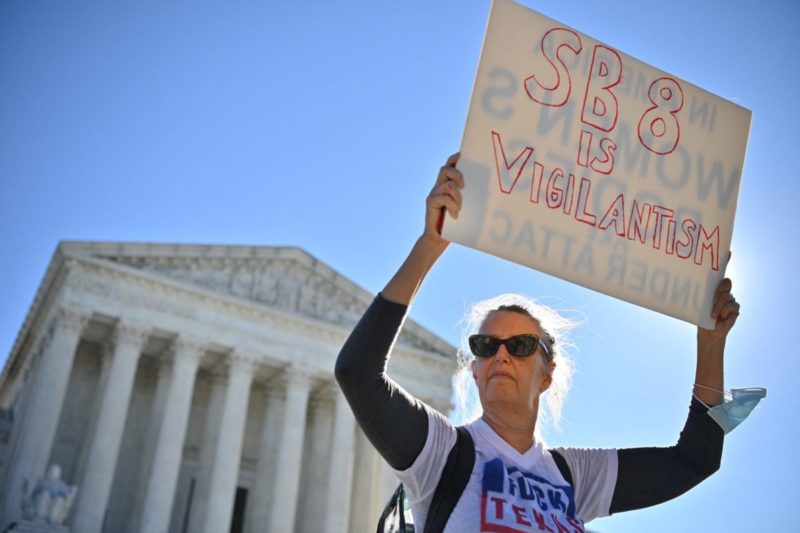Texas Abortion Ban Reality: ‘We Have to Say No to Patients Every Single Day’
While Monday's oral arguments before the Supreme Court had promising moments, abortion providers stressed it does little for the reality in Texas.

For more coverage on Texas SB 8, check out our special report.
Dr. Bhavik Kumar, an abortion provider with Planned Parenthood in Texas, said the two months since Texas SB 8 went into effect have been the hardest of his career.
“We’ve seen patients who are survivors of rape and incest, patients who are still children—as young as 12—and don’t even understand how their body works yet, let alone how to begin to navigate a pregnancy on top of the trauma of sexual abuse,” he said. “We’ve seen patients who are homeless, struggling with drug addiction, and know they can’t support a child. We’ve seen patients who fear a pregnancy will tether them to an abusive partner.”
“No matter their circumstances, all of these people have a right to control their own bodies and should have the freedom to determine their own futures,” Kumar added. “For 62 days, the state of Texas has robbed them of that right.”
Kumar spoke on a press call Monday after the Supreme Court finished hearing oral arguments in two challenges to Texas SB 8, which bans nearly all abortions in the state after embryonic cardiac activity can be detected—around six weeks’ gestation. The first challenge, Whole Woman’s Health v. Jackson, came from abortion providers in the state, followed by a challenge from the Department of Justice in United States v. Texas.
The primary issue in both cases is the law’s enforcement mechanism—the so-called bounty hunter provision that confers standing on average Texans to sue providers to enforce SB 8. This radical move was designed specifically to circumvent the existing precedent about who can interfere with the constitutional right to abortion. By shifting that burden to private citizens and off the state, Texas lawmakers hoped that SB 8 would succeed where other abortion restrictions were struck down.
And so far, that plan has worked. The law has been ping-ponging through federal courts for two months now, and has been in effect the entire time, save for a two-day window when it was enjoined. Meanwhile, patients have been unable to access health care.
“We’ve seen patients who’ve birth control failed, we’ve seen patients who know they can’t possible find the time and resources to leave Texas for an abortion who have turned to corners of the internet in search of herbs or teas to end their own pregnancies,” Kumar said. “We’ve seen those patients walk into our health center in pain when whatever they found didn’t work.”
Monday’s arguments were a chaotic scramble of procedural intricacies during which the justices questioned the impact that allowing SB 8 to stand would have not only on abortion access but on other constitutional rights going forward. While some justices, like Samuel Alito and Neil Gorsuch, were openly hostile to the challengers, others were less convinced about the merits of the precedent SB 8 would set. Julia Kaye, a staff attorney with the ACLU Reproductive Freedom Project, noted on the press call that even Justice Amy Coney Barrett seemed skeptical of the bounty provision of SB 8. Kaye said Barrett seemed to recognize that the way the law is drafted is an affront to the constitution.
Marc Hearron, senior counsel at the Center for Reproductive Rights, argued before the Supreme Court in the Whole Woman’s Health v. Jackson hearing. Later, he called the questioning by the justices “heartening” and said he was “happy to see the justices had serious concerns about outsourcing enforcement” of the law, pointing out that if the Supreme Court were to allow SB 8 to go into effect, that precedent could be used to nullify any constitutional right simply by shifting the enforcement from the state.
It’s perhaps this ripple effect—that the mechanism of deputizing citizens to enforce restrictions on constitutionally protected rights could be used to restrict other rights, like the right to marriage equality, voting, and gun rights—that could sway some of the more conservative justices to rule against SB 8.
Despite glints of optimism, providers stressed that while the arguments had promising moments, it does little for the reality on the ground in Texas right now, and that the Court needs to issue an injunction as soon as possible to prevent further harm.
“Abortion rights are under threat like never before,” said Amy Hagstrom Miller, founder and CEO of Whole Woman’s Health. “Texans have been forced to remain pregnant against their will or to travel out of state [for care],” she said. “We have to say no to patients every single day.”
Other providers shared in this sentiment. Cerita Burrell, the director of programs at the Afiya Center, an organization centered on helping Black women achieve reproductive freedom, stressed that these laws come down the hardest on marginalized populations in Texas. “Black women bear the brunt of this ban,” Burrell said.
Kumar made clear that what we are seeing right now in Texas and at the Supreme Court is not a reflection of any actual moral or legal question regarding abortion but rather an entirely fabricated controversy created by conservatives as a means of marginalization.
“In Texas we’ve been living in a post-Roe world,” Kumar said. “Throughout time people have always sought ways to end pregnancies they cannot carry. Abortion access is not a modern issue but rather has become politicized by extremists weaponizing abortion as a tool of oppression.”
Attorneys were unsure when to expect a decision from the Court on these cases, but said the accelerated timeline for oral arguments could indicate an awareness of the urgency of this issue. Still, with a conservative supermajority on the bench and the Court’s failure to block the law thus far, any optimism comes with a significant amount of trepidation.
